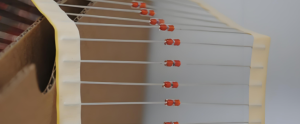
In the wave of modern technology, Negative Temperature Coefficient (NTC) sensors play a crucial role in various industries such as home appliances, automotive, medical, and aerospace, due to their excellent temperature sensitivity and high reliability. As these industries thrive, the market demand for NTC temperature sensors continues to grow, and the requirements for production efficiency and quality are becoming increasingly stringent.
1.Production Challenges of NTC Temperature Sensors
In the production process of NTC sensors, a critical step is the soldering of the thermistor to the lead wires. This step is essential to ensure the effective separation between the temperature sensing point and the control unit. However, many factories still rely on manual soldering, a method that is not only inefficient and unable to meet the growing market demand, but also challenges the profitability of companies as labor costs continue to rise. As a result, the development of automated equipment to replace manual soldering has become an urgent need in the industry.
2.The Necessity of Automated Soldering
The good contact between the thermistor leads and the lead wires is essential to ensure the quality of the soldering. To achieve this, the development of automated soldering technology is particularly crucial. Automated soldering not only improves production efficiency but also ensures consistency in soldering quality, thereby enhancing the reliability and durability of the products.
3.Technical Advantages of Laser Soldering Equipment
Laser soldering equipment, as a high-precision welding technology, has demonstrated its unique advantages in the electronics manufacturing field. This equipment melts solder balls instantly through a precisely controlled laser beam and precisely sprays the molten solder onto the welding surface, forming stable and reliable solder joints. The key components of this system include the laser generator, high-precision automatic ball feeding and spraying mechanisms, and the control system, all of which work together to ensure a highly automated and precise soldering process.
1.Constant Solder Amount: Ensures consistency and repeatability of solder material during the welding process.
2.High Precision: The precise control of the laser allows for micron-level soldering accuracy, making it suitable for high-precision electronic components.
3.Fast Welding Speed: The rapid heating and melting of the pulse laser, combined with the injection of inert gas, significantly shortens the welding cycle.
4.Non-contact: Avoids mechanical stress or damage to sensitive components, which can occur in traditional soldering methods.
5.Small Heat-Affected Zone: The focusing characteristics of the laser limit the heat-affected zone to a very small area, reducing thermal damage to other components or sensitive parts on the circuit board.
4.Conclusion
With continuous technological advancements, automated soldering technology will play an increasingly important role in the production of NTC temperature sensors. Laser soldering equipment, with its characteristics of high precision, high efficiency, and non-contact soldering, has brought about a revolutionary transformation in the electronics manufacturing industry. By adopting this advanced soldering technology, companies can not only improve production efficiency and reduce costs but also ensure product quality and reliability, thereby maintaining a competitive edge in the fierce market. As automation technology continues to evolve, we have reason to believe that the future of electronics manufacturing will be more intelligent and efficient.
